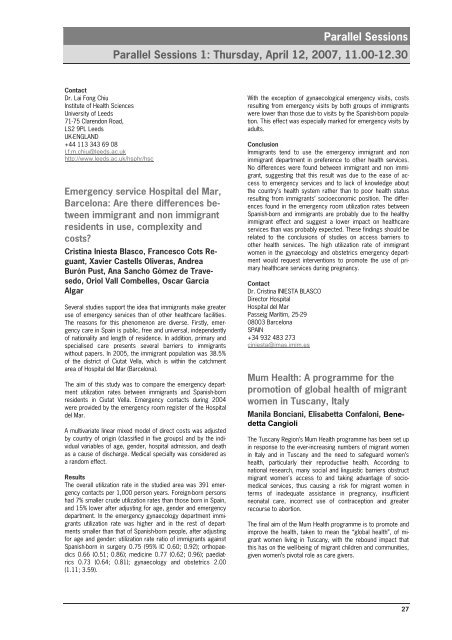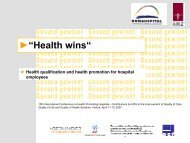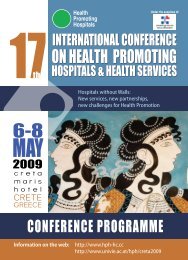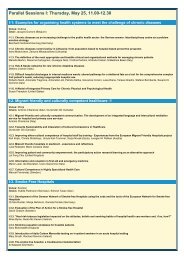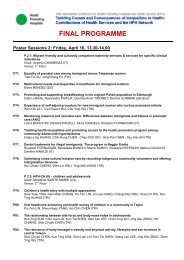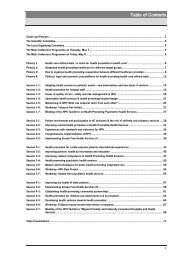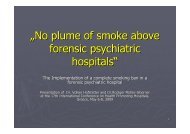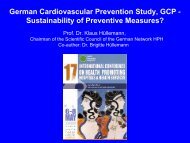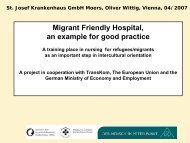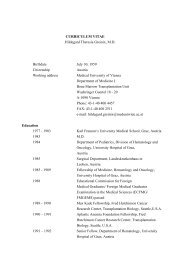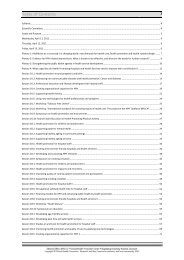Plenary 1: The Hospital – A Staff Empowering ... - HPH-Conference
Plenary 1: The Hospital – A Staff Empowering ... - HPH-Conference
Plenary 1: The Hospital – A Staff Empowering ... - HPH-Conference
You also want an ePaper? Increase the reach of your titles
YUMPU automatically turns print PDFs into web optimized ePapers that Google loves.
Contact<br />
Dr. Lai Fong Chiu<br />
Institute of Health Sciences<br />
University of Leeds<br />
71-75 Clarendon Road,<br />
LS2 9PL Leeds<br />
UK-ENGLAND<br />
+44 113 343 69 08<br />
l.f.m.chiu@leeds.ac.uk<br />
http://www.leeds.ac.uk/hsphr/hsc<br />
Parallel Sessions<br />
Parallel Sessions 1: Thursday, April 12, 2007, 11.00-12.30<br />
Emergency service <strong>Hospital</strong> del Mar,<br />
Barcelona: Are there differences between<br />
immigrant and non immigrant<br />
residents in use, complexity and<br />
costs?<br />
Cristina Iniesta Blasco, Francesco Cots Reguant,<br />
Xavier Castells Oliveras, Andrea<br />
Burón Pust, Ana Sancho Gómez de Travesedo,<br />
Oriol Vall Combelles, Oscar García<br />
Algar<br />
Several studies support the idea that immigrants make greater<br />
use of emergency services than of other healthcare facilities.<br />
<strong>The</strong> reasons for this phenomenon are diverse. Firstly, emergency<br />
care in Spain is public, free and universal, independently<br />
of nationality and length of residence. In addition, primary and<br />
specialised care presents several barriers to immigrants<br />
without papers. In 2005, the immigrant population was 38.5%<br />
of the district of Ciutat Vella, which is within the catchment<br />
area of <strong>Hospital</strong> del Mar (Barcelona).<br />
<strong>The</strong> aim of this study was to compare the emergency department<br />
utilization rates between immigrants and Spanish-born<br />
residents in Ciutat Vella. Emergency contacts during 2004<br />
were provided by the emergency room register of the <strong>Hospital</strong><br />
del Mar.<br />
A multivariate linear mixed model of direct costs was adjusted<br />
by country of origin (classified in five groups) and by the individual<br />
variables of age, gender, hospital admission, and death<br />
as a cause of discharge. Medical specialty was considered as<br />
a random effect.<br />
Results<br />
<strong>The</strong> overall utilization rate in the studied area was 391 emergency<br />
contacts per 1,000 person years. Foreign-born persons<br />
had 7% smaller crude utilization rates than those born in Spain,<br />
and 15% lower after adjusting for age, gender and emergency<br />
department. In the emergency gynaecology department immigrants<br />
utilization rate was higher and in the rest of departments<br />
smaller than that of Spanish-born people, after adjusting<br />
for age and gender: utilization rate ratio of immigrants against<br />
Spanish-born in surgery 0.75 (95% IC 0.60; 0.92); orthopaedics<br />
0.66 (0.51; 0.86); medicine 0.77 (0.62; 0.96); paediatrics<br />
0.73 (0.64; 0.81); gynaecology and obstetrics 2.00<br />
(1.11; 3.59).<br />
With the exception of gynaecological emergency visits, costs<br />
resulting from emergency visits by both groups of immigrants<br />
were lower than those due to visits by the Spanish-born population.<br />
This effect was especially marked for emergency visits by<br />
adults.<br />
Conclusion<br />
Immigrants tend to use the emergency immigrant and non<br />
immigrant department in preference to other health services.<br />
No differences were found between immigrant and non immigrant,<br />
suggesting that this result was due to the ease of access<br />
to emergency services and to lack of knowledge about<br />
the country’s health system rather than to poor health status<br />
resulting from immigrants’ socioeconomic position. <strong>The</strong> differences<br />
found in the emergency room utilization rates between<br />
Spanish-born and immigrants are probably due to the healthy<br />
immigrant effect and suggest a lower impact on healthcare<br />
services than was probably expected. <strong>The</strong>se findings should be<br />
related to the conclusions of studies on access barriers to<br />
other health services. <strong>The</strong> high utilization rate of immigrant<br />
women in the gynaecology and obstetrics emergency department<br />
would request interventions to promote the use of primary<br />
healthcare services during pregnancy.<br />
Contact<br />
Dr. Cristina INIESTA BLASCO<br />
Director <strong>Hospital</strong><br />
<strong>Hospital</strong> del Mar<br />
Passeig Marítim, 25-29<br />
08003 Barcelona<br />
SPAIN<br />
+34 932 483 273<br />
ciniesta@imas.imim.es<br />
Mum Health: A programme for the<br />
promotion of global health of migrant<br />
women in Tuscany, Italy<br />
Manila Bonciani, Elisabetta Confaloni, Benedetta<br />
Cangioli<br />
<strong>The</strong> Tuscany Region’s Mum Health programme has been set up<br />
in response to the ever-increasing numbers of migrant women<br />
in Italy and in Tuscany and the need to safeguard women’s<br />
health, particularly their reproductive health. According to<br />
national research, many social and linguistic barriers obstruct<br />
migrant women’s access to and taking advantage of sociomedical<br />
services, thus causing a risk for migrant women in<br />
terms of inadequate assistance in pregnancy, insufficient<br />
neonatal care, incorrect use of contraception and greater<br />
recourse to abortion.<br />
<strong>The</strong> final aim of the Mum Health programme is to promote and<br />
improve the health, taken to mean the “global health”, of migrant<br />
women living in Tuscany, with the rebound impact that<br />
this has on the well-being of migrant children and communities,<br />
given women’s pivotal role as care givers.<br />
27


